
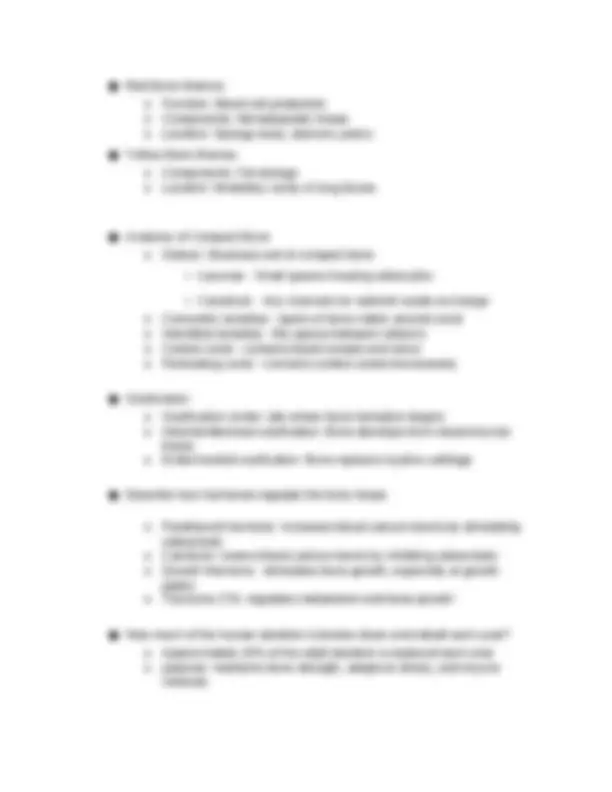
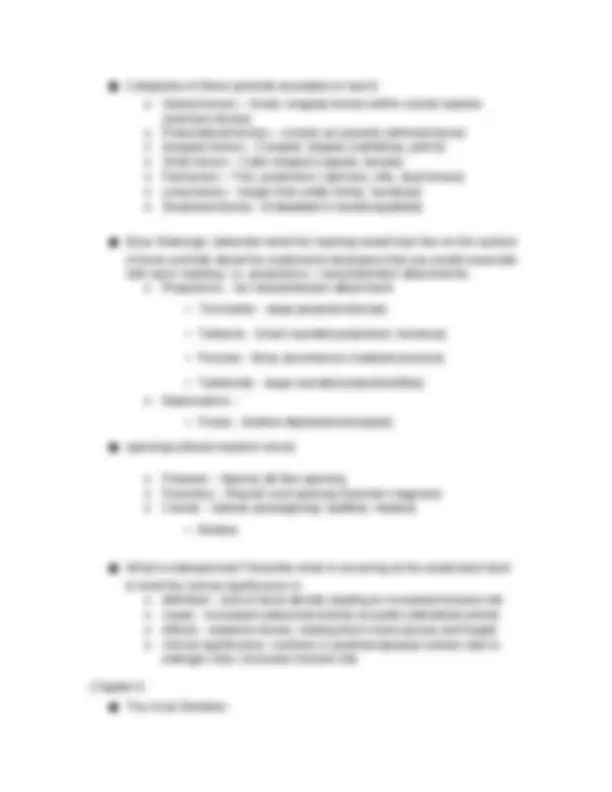
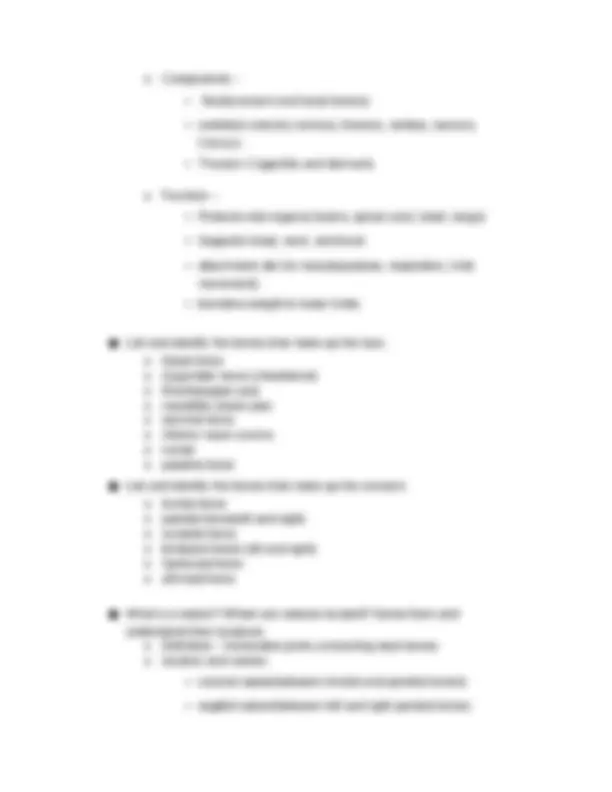
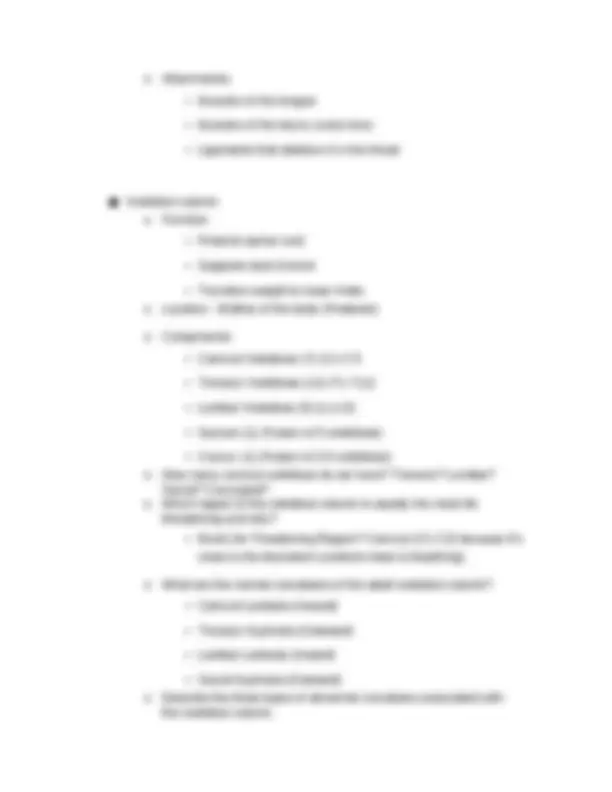
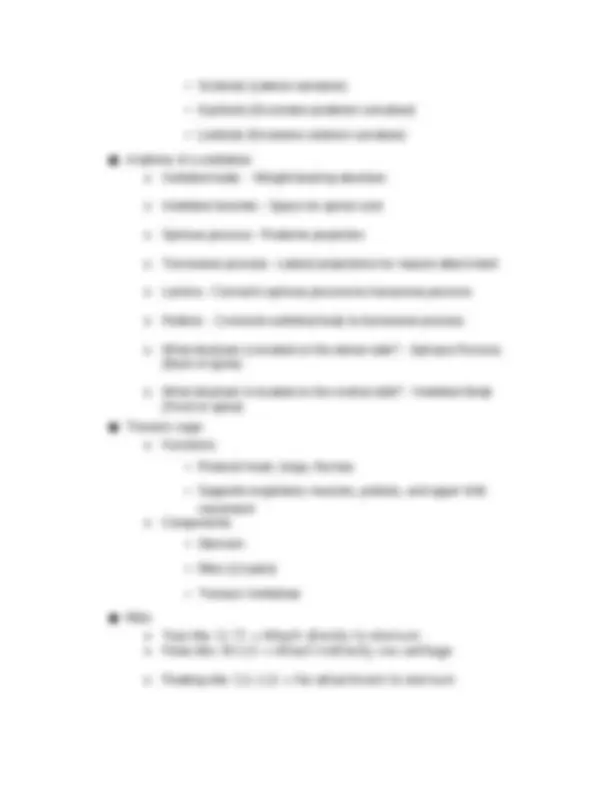
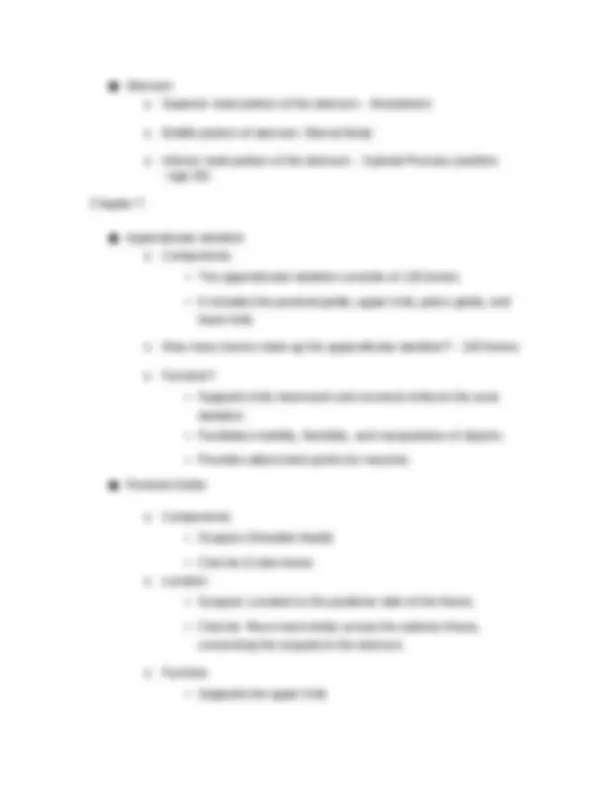
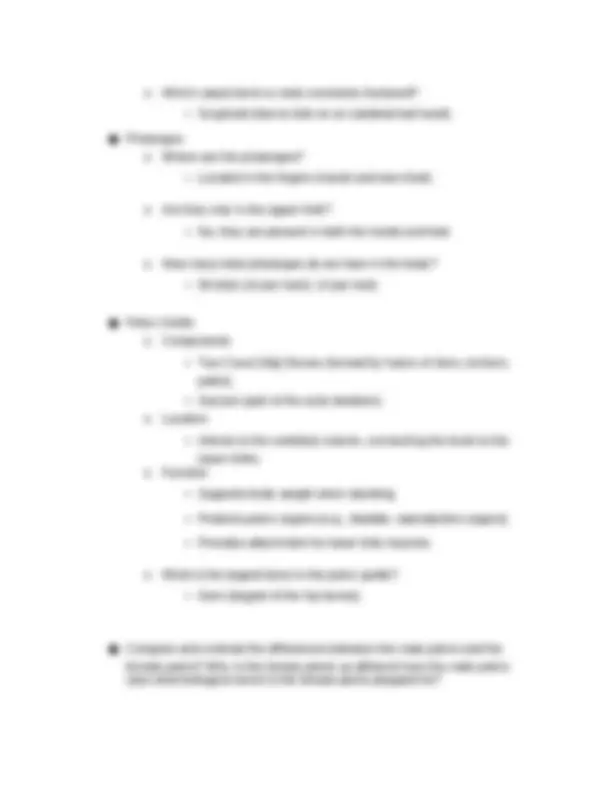
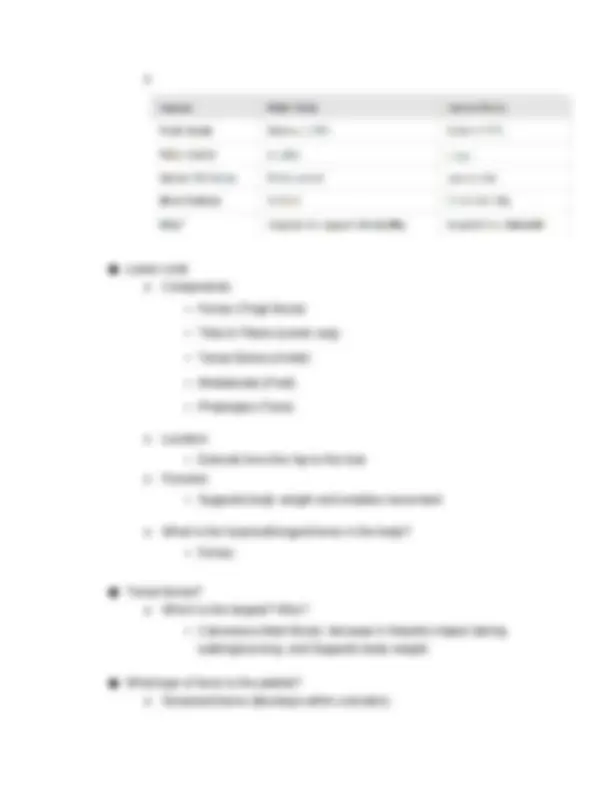
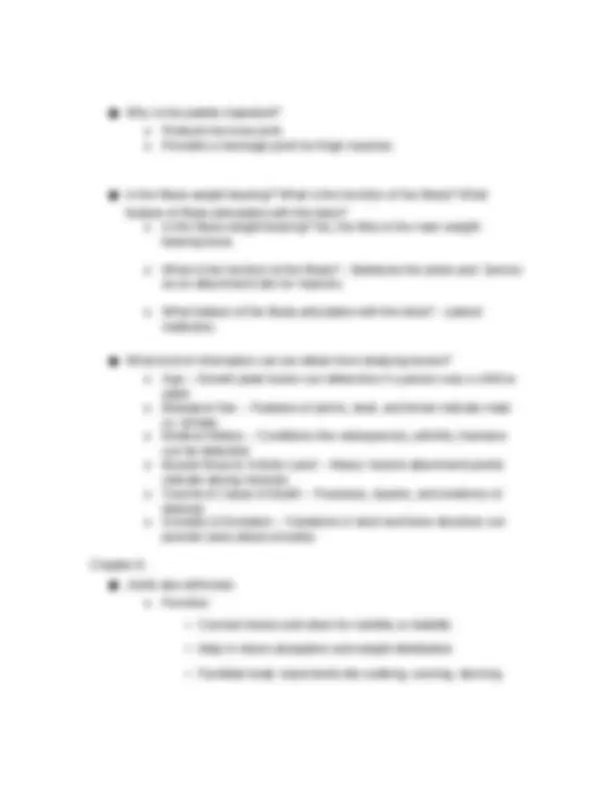
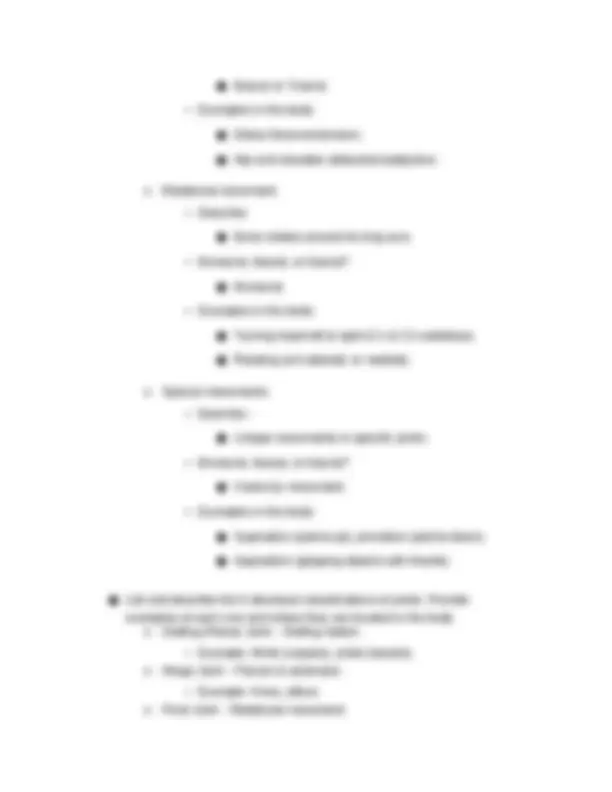
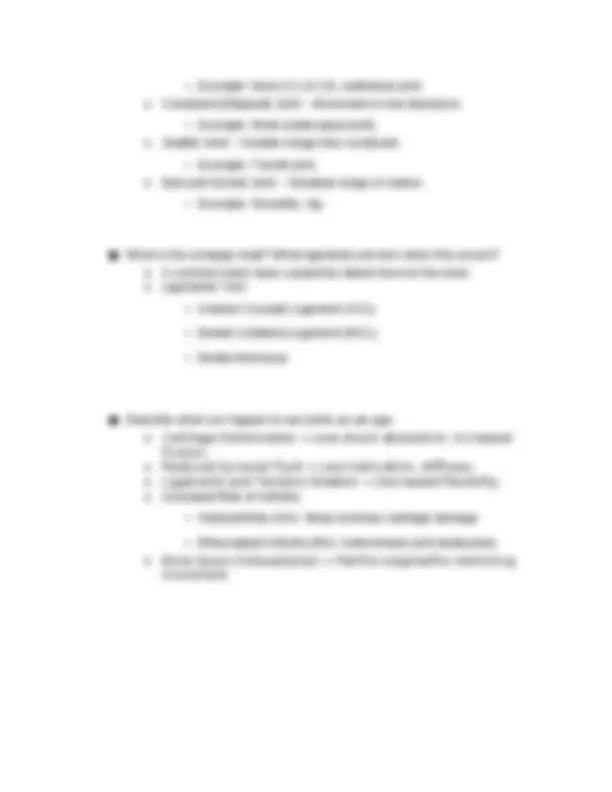


Study with the several resources on Docsity

Earn points by helping other students or get them with a premium plan


Prepare for your exams
Study with the several resources on Docsity

Earn points to download
Earn points by helping other students or get them with a premium plan
Community
Ask the community for help and clear up your study doubts
Discover the best universities in your country according to Docsity users
Free resources
Download our free guides on studying techniques, anxiety management strategies, and thesis advice from Docsity tutors
ANAT260L Week 2 Study Guide Chapter 5,6,7,8 West Coast 2025/2026/ANAT260L Week 2 Study Guide Chapter 5,6,7,8 West Coast 2025/2026
Typology: Quizzes
1 / 19

This page cannot be seen from the preview
Don't miss anything!












Week 2 Study Guide ANAT 260 OL Blezinski Chapters 5, 6, 7 & 8 Chapter 5: ● Function(s) of the skeletal system: o support o protection o movement o storage o blood cell production ● Bone is categorized as what tissue type? o Osseous Connective Tissue ● Composition of bone: o Organic collagen fibers and inorganic calcium phosphate Bone cells and their function ● Osteocytes: maintains bone tissue ● Osteoblasts: builds bone tissue ● Osteoclasts: breaks down bone tissue ● Osteoprogenitor cells: stem cells for bone repair Type of bone ● Compact bone: o Function: support and resist stress o Structure:dense, contains osteons o Anatomy of the osteon: ▪ Central canal - a big tunnel in the middle with blood and nerves to keep the bone alive ▪ Lamellae - rings around the central canal that make the bone hard and strong ▪ lacunae - tiny for bone cells(osteocytes) sitting between the rings
▪ canaliculi - tiny roads that let the bone cells talk to each other and get food from the blood ▪ perforating canal - side tunnel that connects different osteon so blood and nerves can travel everywhere ● Spongy bone: o Function: reduce weight, allows space for marrow o Structure: trabeculae with open spaces filled with bone marrow ● Periosteum: o Location: outer surface of bones o Function: Protects and nourishes bone, attachment for tendons/ ligaments o Tissue Type: Dense Irregular connective tissue o What are Sharpey’s Fibers aka Perforating Fibers? Anchor periosteum to bone ● Endosteum: o Location: Lines medullary cavity o Function: Bone growth and remodeling o Tissue Type: Thin connective tissue membrane Bone structures: ● Epiphysis: End of long bone, contains red marrow ● Diaphysis: Shaft of long bone ● Metaphysis: Region between epiphysis and diaphysis ● Epiphyseal plate - Growth plate of cartilage ● Medullary Cavity: Central cavity in diaphysis, contains marrow
● Categories of Bone (provide examples of each): o Sutural bones – Small, irregular bones within cranial sutures (wormian bones) o Pneumatized bones – contain air pockets (ethmoid bone) o Irregular bones – Complex shapes (vertebrae, pelvis) o Short bones – Cube shaped (carpals, tarsals) o Flat bones – Thin, protective ( sternum, ribs, skull bones) o Long bones – longer than wide( femur, humerus) o Sesamoid bones - Embedded in tendons(patella) ● Bony Markings: (describe what the marking would look like on the surface of bone and talk about the anatomical structures that you would associate with each marking. i.e. projections = muscle/tendon attachments. o Projections – for muscle/tendon attachment ▪ Trochanter - large projection(femur) ▪ Tubercle - Small rounded projection( humerus) ▪ Process - Bony prominence (mastoid process) ▪ Tuberosity - large rounded projection(tibia) o Depressions – ▪ Fossa - shallow depression(scapula) ● openings (blood vessels/ nerve) o Fissures – Narrow slit like opening o Foramina – Round/ oval opening (foramen magnum) o Canals – tubular passageway( auditory meatus) ▪ Meatus ● What is osteoporosis? Describe what is occurring at the anatomical level & what the clinical significance is. o definition - loss of bone density leading to increased fracture risk o cause - increased osteoclast activity exceeds osteoblast activity o effects - weakens bones, making them more porous and fragile o clinical significance: common in postmenopausal women due to estrogen loss; increases fracture risk. Chapter 6: ● The Axial Skeleton:
o Components – ▪ Skull(cranium and facial bones) ▪ vertebral column( cervical, thoracic, lumbar, sacrum, Coccyx) ▪ Thoracic Cage(ribs and sternum) o Function – ▪ Protects vital organs( brains, spinal cord, heart, lungs) ▪ Supports head, neck, and trunk ▪ attachment site for muscle(posture, respiration, limb movement) ▪ transfers weight to lower limbs ● List and identify the bones that make up the face. o Nasal bone o Zygomatic bone (cheekbone) o Maxilla(upper jaw) o mandible (lower jaw) o lacrimal bone o inferior nasal concha o vomer o palatine bone ● List and identify the bones that make up the cranium. o frontal bone o parietal bone(left and right) o occipital bone o temporal bone( left and right) o Sphenoid bone o ethmoid bone ● What is a suture? Where are sutures located? Name them and understand their locations o Definition - Immovable joints connecting skull bones o location and names ▪ coronal suture(between frontal and parietal bones) ▪ sagittal suture(between left and right parietal bones
o What structure(s) pass through the foramen magnum? ▪ Spinal Cord ▪ Vertebral Arteries ▪ Accessory Nerve (Cranial Nerve XI) ● Sphenoid Bone: o Sella Turcica - Houses the Pituitary Gland ▪ What structure sits in the sella turcica? - PITUITARY GLAND o Optic canal - Passage for Optic Nerve (Cranial Nerve II) o Optic groove - Where Optic Chiasm sits o Lesser Wing - Forms part of the orbit o Greater Wing - Extends laterally, forming part of skull base ● Ethmoid Bone: o Why is the Ethmoid bone considered a pneumatized bone? - because it contains air cells/sinuses o Cribriform plate: Roof of nasal cavity, passage for Olfactory Nerve o Perpendicular plate - Forms superior part of the nasal septum o Nasal Concha (which one is part of the ethmoid bone) ▪ Middle & Superior Conchae (part of Ethmoid Bone) ▪ Inferior Conchae (separate bone) ● List the bones that make up the bony orbit. o Frontal Bone o Sphenoid Bone o Ethmoid Bone o Zygomatic Bone o Maxilla o Lacrimal Bone o Palatine Bone ● What makes the hyoid bone unique? What muscles/ligaments attach to the hyoid bone and keep it in place? o Unique Feature: Does not articulate with any other bone
o Attachments: ▪ Muscles of the tongue ▪ Muscles of the larynx (voice box) ▪ Ligaments that stabilize it in the throat ● Vertebral column: o Function ▪ Protects spinal cord ▪ Supports skull & trunk ▪ Transfers weight to lower limbs o Location - Midline of the body (Posterior) o Components: ▪ Cervical Vertebrae (7) (C1-C7) ▪ Thoracic Vertebrae (12) (T1-T12) ▪ Lumbar Vertebrae (5) (L1-L5) ▪ Sacrum (1) (Fusion of 5 vertebrae) ▪ Coccyx (1) (Fusion of 3-5 vertebrae) o How many cervical vertebrae do we have? Thoracic? Lumbar? Sacral? Coccygeal? o Which region of the vertebral column is usually the most life threatening and why? ▪ Most Life-Threatening Region? Cervical (C1-C2) because it's close to the brainstem (controls heart & breathing). o What are the normal curvatures of the adult vertebral column? ▪ Cervical Lordosis (Inward) ▪ Thoracic Kyphosis (Outward) ▪ Lumbar Lordosis (Inward) ▪ Sacral Kyphosis (Outward) o Describe the three types of abnormal curvatures associated with the vertebral column.
● Sternum: o Superior most portion of the sternum: - Manubrium o Middle portion of sternum: Sternal Body o Inferior most portion of the sternum: - Xiphoid Process (ossifies ~age 30) Chapter 7: ● Appendicular skeleton o Components ▪ The appendicular skeleton consists of 126 bones. ▪ It includes the pectoral girdle, upper limb, pelvic girdle, and lower limb. o How many bones make up the appendicular skeleton? - 126 bones. o Function? ▪ Supports limb movement and connects limbs to the axial skeleton. ▪ Facilitates mobility, flexibility, and manipulation of objects. ▪ Provides attachment points for muscles. ● Pectoral Girdle o Components ▪ Scapula (Shoulder blade) ▪ Clavicle (Collar bone) o Location ▪ Scapula: Located on the posterior side of the thorax. ▪ Clavicle: Runs horizontally across the anterior thorax, connecting the scapula to the sternum. o Function ▪ Supports the upper limb.
▪ Provides attachment sites for muscles that move the upper limb. o Movements? ▪ Elevation – Raising the shoulders (shrugging). ▪ Depression – Lowering the shoulders. ▪ Protraction – Moving shoulders forward. ▪ Retraction – Moving shoulders backward. ● Upper Limb: o Components: ▪ Humerus (Upper Arm) ▪ Radius & Ulna (Forearm) ▪ Carpal Bones (Wrist) ▪ Metacarpals (Hand) ▪ Phalanges (Fingers) o Location: ▪ Extends from the shoulder to the hand. o Humerus: ▪ Capitulum - Articulates with the radius. ▪ Greater tubercle - Large lateral projection for muscle attachment. ▪ Lesser tubercle - Smaller anterior projection for muscle attachment. ▪ Medial/Lateral epicondyle - Protrusions on distal end for ligament and muscle attachment. o Radius ▪ Radial notch- Located on the ulna, where the head of the radius articulates.
o Which carpal bone is most commonly fractured? ▪ Scaphoid (due to falls on an outstretched hand). ● Phalanges o Where are the phalanges? ▪ Located in the fingers (hand) and toes (foot). o Are they only in the upper limb? ▪ No, they are present in both the hands and feet. o How many total phalanges do we have in the body? ▪ 56 total (14 per hand, 14 per foot). ● Pelvic Girdle o Components ▪ Two Coxal (Hip) Bones (formed by fusion of ilium, ischium, pubis). ▪ Sacrum (part of the axial skeleton). o Location ▪ Inferior to the vertebral column, connecting the trunk to the lower limbs. o Function ▪ Supports body weight when standing. ▪ Protects pelvic organs (e.g., bladder, reproductive organs). ▪ Provides attachment for lower limb muscles. o What is the largest bone in the pelvic girdle? ▪ Ilium (largest of the hip bones). ● Compare and contrast the differences between the male pelvis and the female pelvis? Why is the female pelvis so different from the male pelvis (aka what biological event is the female pelvis prepped for?
o ● Lower Limb o Components ▪ Femur (Thigh Bone) ▪ Tibia & Fibula (Lower Leg) ▪ Tarsal Bones (Ankle) ▪ Metatarsals (Foot) ▪ Phalanges (Toes) o Location ▪ Extends from the hip to the foot. o Function ▪ Supports body weight and enables movement. o What is the heaviest/longest bone in the body? ▪ Femur. ● Tarsal bones? o Which is the largest? Why? ▪ Calcaneus (Heel Bone). because it Absorbs impact during walking/running. and Supports body weight. ● What type of bone is the patella? o Sesamoid bone (develops within a tendon).
● Most common cartilage type in joints (located on the articular surface)? o Hyaline cartilage (Articular Cartilage) ▪ Smooth & glassy texture to reduce friction. ▪ Covers ends of bones in synovial joints. ▪ Provides shock absorption. ● Classifications of joints based on motion: o Synarthrosis: No movement between bones. ▪ Example: ● Sutures of the skull (e.g., coronal, sagittal, lambdoid sutures). ● Gomphosis (teeth in sockets). o Amphiarthrosis: -Limited movement, bones connected by cartilage or fibrous tissue. ▪ Example: ● Pubic symphysis (between left & right pubic bones). ● Intervertebral discs (between vertebrae). o Diarthrosis: Full range of motion, also known as synovial joints. ▪ Example: ● Shoulder joint (ball-and-socket). ● Knee joint (hinge joint). ● What are the six characteristics of synovial joints? o Joint Capsule – Surrounds the joint, provides stability. o Articular Cartilage – Hyaline cartilage that reduces friction. o Joint Cavity (Synovial Cavity) – Space between bones filled with synovial fluid. o Synovial Fluid – Lubricates, nourishes cartilage, absorbs shock. o Ligaments – Connect bone to bone for stability. o Nerves & Blood Vessels – Provide nutrients and detect pain.
What structure surrounds the synovial joint? o Joint capsule (fibrous connective tissue) encloses the joint. What is a bursae? o Fluid-filled sacs found near joints. o Function: Reduce friction between bones, tendons, and muscles. ● What is the function of synovial fluid? o Lubricates the joint (reduces friction). o Nourishes articular cartilage. o Absorbs shock to protect bones. ● What are the 4 important accessory structures of synovial joints? o List and describe all four ▪ Menisci – Fibrocartilage pads for shock absorption & joint stability (e.g., knee). ▪ Ligaments – Bone-to-bone connections prevent excessive movement. ▪ Tendons – Muscle-to-bone connections stabilize joints. ▪ Bursa Sacs – Fluid-filled sacs that reduce friction. ● Classification of joints based on movement: o Linear movement: - gliding movement ▪ Describe: - Two flat surfaces slide past each other. ▪ Monaxial, biaxial, or triaxial? - (one direction) ▪ Examples in the body: - ● Carpal (wrist) & tarsal (ankle) joints. ● Clavicle & sternum joint. o Angular movement: ▪ Describe: - ● Changes angle between bones. ▪ Monaxial, biaxial, or triaxial?
▪ Example: Neck (C1 & C2), radioulnar joint. o Condyloid (Ellipsoid) Joint – Movement in two directions. ▪ Example: Wrist (radiocarpal joint). o Saddle Joint – Greater range than condyloid. ▪ Example: Thumb joint. o Ball-and-Socket Joint – Greatest range of motion. ▪ Example: Shoulder, hip. ● What is the unhappy triad? What ligaments are torn when this occurs? o A common knee injury caused by lateral force to the knee. o Ligaments Torn: ▪ Anterior Cruciate Ligament (ACL) ▪ Medial Collateral Ligament (MCL) ▪ Medial Meniscus ● Describe what can happen to our joints as we age. o Cartilage Deteriorates → Less shock absorption, increased friction. o Reduced Synovial Fluid → Less lubrication, stiffness. o Ligaments and Tendons Weaken → Decreased flexibility. o Increased Risk of Arthritis: ▪ Osteoarthritis (OA): Wear-and-tear cartilage damage. ▪ Rheumatoid Arthritis (RA): Autoimmune joint destruction. o Bone Spurs (Osteophytes) → Painful outgrowths restricting movement.